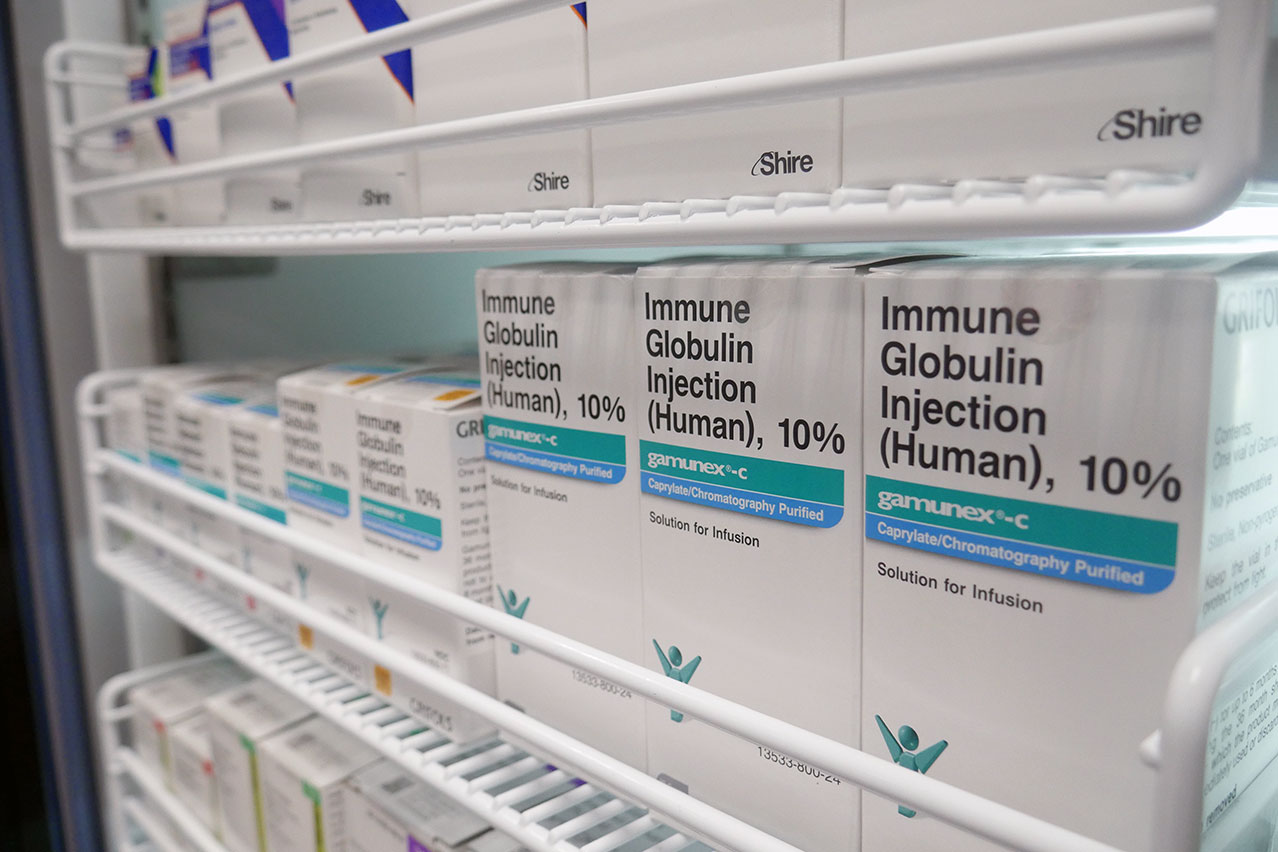
What Is Immune Globulin?
Immune globulins, also called immunoglobulins, are proteins secreted by our white blood cells. Immunoglobulins are glycoproteins that act as antibodies that recognize antigens such as bacteria or viruses and destroy them.
While babies initially receive immunoglobulins from their mothers through transplacental transfer, the levels may reduce with time, resulting in immunodeficiency. Immunoglobulin replacement therapy can help fight several infections and diseases that arise due to this deficiency.
Get IVIG Prior Authorization
What Is Immune Globulin Injection?
Immunoglobulin injection is a blood product used to treat several infections in individuals who have a compromised immune system and are highly susceptible to multiple infections. This blood product is derived from pooled blood donations, where thousands of healthy blood donors donate their blood.
Immunoglobulins are typically used for infusion for long-term treatments such as primary immunodeficiency, inflammatory conditions, deficiency of a particular antibody, and several other secondary immune conditions.
Routes of Administration for Immunoglobulin Injection
Therapeutic immunoglobulin can be given via intravenous (IV) or subcutaneous (SC) route. The route of administration depends on the individual patient and the medical status of the patient. Other factors such as availability of intravenous access, the total monthly dose needed by the patient, tolerability of the dose, and patient preference also determine which route to choose. Although both routes of administration provide similar efficacy in preventing serious bacterial infections, each offers advantages and disadvantages.
One clear advantage of intravenous immunoglobulin (IVIG) over subcutaneous injection is that it can be infused in larger volumes. Therefore, the peak level is reached rapidly, and the immunoglobulin can be given less frequently. The IV route is preferred in patients who need high-dose treatment either during acute infection or for immunomodulating effects.
Newer IVIG preparations are generally associated with fewer infusion-related adverse effects because of improved manufacturing methods that remove immunoglobulin aggregates. However, intravenous immunoglobulin is still associated with more frequent systemic adverse effects than subcutaneous injections.
A subcutaneous infusion is preferred for patients with poor venous access, cardiac problems, renal failure, and patient independence. This injection can be self-administered or given by a partner without needing assistance from an infusion nurse. Thus, the advantages of subcutaneous immunoglobulin injection include improved quality of life, independence during the treatment, flexibility, and portability of the injection.
What Is Immunoglobulin Injection Given for?
Immune globulin injection is a type of immunoglobulin replacement therapy for people suffering from primary antibody deficiency. Primary antibody deficiency is a condition that arises from primary immunodeficiency diseases or certain genetic conditions. The main aim of immune globulin injection is to reduce the severity of a wide spectrum of infections by strengthening the body’s immune defense system.
Immunoglobulin is largely used to treat patients with impaired antibody production. The passive transfer of antibodies protects against broad categories of infectious pathogens. In patients with significant antibody deficiencies such as congenital agammaglobulinemia and common variable immunodeficiency (CVID), immunoglobulin injections effectively prevent pneumonia and several other serious bacterial infections. The treatment is usually lifelong for these patients.
A short treatment trial of IVIG can be beneficial in a certain subset of patients with other partial primary antibody defects. These patients can be diagnosed with transient hypogammaglobulinemia of infancy, an immunoglobulin subclass deficiency, or other primary immunodeficiency disease conditions that also have poor specific antibody responses to infectious or immunization agents. In conditions that result in secondary hypogammaglobulinemia, such as drug effects, malignancies, or renal or gastrointestinal loss, immunoglobulin is not beneficial except in select cases.
Get IVIG Copay Assistance
Speak to a SpecialistDifferent Types of Immunoglobulins
The human body makes a few different types of immunoglobulin antibodies:
- Immunoglobulin A (IgA): IgA is present in the mucous membranes of the lungs, sinuses, stomach, and intestines.
- Immunoglobulin G (IgG): This is the most common type of immunoglobulin antibody. It protects us from infection by “remembering” the disease-causing bacteria or virus that we have been exposed to earlier.
- Immunoglobulin M (IgM): These immunoglobulins are the first ones prepared by our bodies when we are exposed to a new kind of germ.
- Immunoglobulin E (IgE): These antibodies are produced against allergies.
- Immunoglobulin D (IgD): These antibodies are present at very low levels (less than 1%). Their exact function is not known.
How To Tell if Intravenous Immunoglobulin (IVIG) Is Working
Tracking your immunoglobulin blood levels and watching for the symptoms of diseases is the best way to know whether the treatment with immunoglobulin injection is working.
Doctors will evaluate patients for clinical improvements after the treatment is initiated. After the first three months of administering the immunoglobulin injection, it is necessary to monitor the immunoglobulin levels in the blood. If the patient has reached normal levels, the next monitoring can be scheduled after 6 to 12 months.
If the patient has conditions such as pregnancy, weight gain, frequent bacterial infections, or is entering puberty, the treatment needs to be modified. Your doctor will either shorten the interval between two injections or adjust the dose. Many times, doctors might suggest shifting to subcutaneous injections.
Immunoglobulin Injection Doses
IVIG manufacturers recommend starting rates of 0.5 to 1 mg/kg/min. These doses can be further increased gradually up to a rate of 3.3 to 8 mg/kg/min. Each Infusion normally takes 2 to 6 hours when administered at a replacement dosage of 400 to 600 mg/kg per dose.
Higher infusion rates have been associated with more infusion-related reactions and side effects such as thromboembolic complications. Therefore, it may be necessary to administer the infusion at a slower rate as the severity of infusion-related reactions is usually reduced when IVIG injections are administered at a slower rate, such as 0.5 to 1 mg/kg/min.
The FDA recommends that infusion rates should be kept at 3 to 4 mg/kg/min in patients who are at risk of renal failure or thrombosis. Infusions can be administered via peripheral or central intravenous access. Some patients may need lifelong immunoglobulin treatment; however, in such cases, a central venous catheter or port-a-cath placement solely for infusing IVIG injection is not recommended because of the risks of infection and thrombosis.
When switching from IVIG to SCIG, the first subcutaneous infusion is usually given 1 to 2 weeks after the last IV infusion, as described in most U.S. licensing studies. It takes 5 to 12 weeks to achieve a new, steady state when switching from IVIG to SCIG, initiating SCIG in a patient, or making a change in the weekly dosage. Typically, SCIG is administered weekly, but one 20% product was recently approved for administration at variable frequencies, including daily, weekly, or biweekly, providing even more flexible scheduling.
SCIG can be administered by gradual infusion or can be rapidly pushed into body sites where there is enough subcutaneous fat, such as the abdominal wall, inner thigh, posterior upper arm, flanks, or below the buttocks. The infusion can be given via one to six sites, depending on the total volume. Administration might take 30 to 90 minutes via infusion pump or 5 to 20 minutes via rapid push. Both methods are practical and well-tolerated.
Get Your IVIG Dose
At-Home InfusionAt-Home Injections
Since subcutaneous immunoglobulin injections can be self-administered, the patient has the luxury of infusing while at home or traveling.
In one study, IVIG was administered in the home setting for patients with multifocal motor neuropathy (MMN) and chronic inflammatory demyelinating polyradiculoneuropathy. Clinical trials on such patients have shown that this is a safe and effective option for patients requiring frequent IVIG doses.
Receiving IVIG in home-based settings is cost-effective compared to receiving the therapy in a hospital setting.
Side Effects of Immunoglobulin Injections
Although a large number of clinical trials have reported the benefits of immunoglobulin injection therapy in diseases related to immunoglobulin deficiency, there have been reports of several adverse effects.
A vast majority of the population taking immunoglobulin therapy experience common side effects such as:
- Flushing
- Headache
- Malaise
- Fever
- Chills
- Fatigue and lethargy
- Eczema
- Dermatitis
- Lowered blood pressure
- Increased heartbeat
- Nausea
- Diarrhea
- Bronchospasm
- Cough
Some rare side effects include:
- Renal impairment
- Thrombosis
- Arrhythmia
- Aseptic meningitis
- Hemolytic anemia
- Transfusion-related acute lung injury (TRALI)
Can IVIG help?
Free IVIG Treatment InfoSome side effects occur due to changes in the brand of immunoglobulin injection. Side effects may also occur due to the other ingredients in the injection formulation or because of the speed of administration.
Assessing the involved risk factors beforehand, infusing at a slow rate, premedicating, and switching from IVIG to subcutaneous immunoglobulin can minimize adverse effects. Adverse effects are rarely disabling or fatal. Treatment mainly involves supportive measures, and the majority of affected patients have a good prognosis.
Overall, IVIG is considered a safe therapy when given at a slow infusion rate in well-hydrated patients.
Diseases Treated With Immune Globulin Injections
Immune globulin injection is a preferred replacement therapy for immunoglobulin deficiency. The currently available immunoglobulin injections are licensed for use in FDA-approved indications.
The diseases treated may be categorized depending on the level of need for immunoglobulin injection therapy:
High priority:
- Chronic inflammatory demyelinating polyneuropathy (a neurological disorder that causes weakness)
- Guillain-Barre syndrome (a rare condition that affects the nervous system)
- Immune thrombocytopenic purpura (an immune blood disorder that reduces platelets leading to internal bleeding)
- Kawasaki disease (fever; rashes; red eyes; swollen and inflamed lips, mouth, or throat; especially in children below 5 years of age)
- Primary immune deficiency
- Specific antibody deficiency
- Toxic epidermal necrolysis (life-threatening peeling or blistering of skin)
Medium priority:
- Immunobullous disease (a skin disorder with blistering caused by pathogens)
- Inflammatory myopathies (muscle inflammation and weakness)
- Multifocal motor neuropathy (a disorder affecting the body’s motor nerves)
- Myasthenia gravis (a neuromuscular disease causing skeletal weakness)
- Secondary antibody deficiency
- Streptococcal or staphylococcal septic shock (life-threatening illness caused by bacteria)
Low priority: Autoimmune encephalitis (inflammation of the covering of the brain)
Is Immunoglobulin Made From Humans?
Immunoglobulin is made from human blood. When blood is donated and spun to separate the blood components, the clear liquid fraction of blood is called plasma. Plasma contains antibodies that are separated for injection purposes.
Ask About IVIG Home Infusion
Is IVIG the Same as Immunotherapy?
IVIG is considered a type of immunotherapy because it is used to treat many different autoimmune disorders, infections, or other conditions. It also helps prevent infections in patients who have had a stem cell or organ transplant.
Cost of IVIG Treatment
The cost of IVIG treatment will depend upon the patient’s disease status, need, and frequency of medication. Hence, the cost will differ from person to person. On average, IVIG costs $200 to $350 per gram. However, this cost may vary according to different brands. The treatment cost for Guillain-Barre syndrome is about $20,000, and for other indications, the costs might exceed $30,000.
AmeriPharma™ Specialty Care offers Infusion therapy in the comfort of your home, which can help reduce costs compared to receiving the infusion at the hospital or infusion center.
If you are interested in receiving IVIG therapy at home, consult with a specialist at AmeriPharma™ to further discuss your options.
What If I Miss a Dose of Immune Globulin Injection?
If you are unable to keep an appointment, call your doctor or health care professional. If you give yourself the medicine and you miss a dose, take it as soon as you can. If it is almost time for your next dose, take only the next dose. Do not take double or extra doses.
Do Immune Globulin Injections Cause Blood Clots?
Intravenous immunoglobulin may increase the risk of blood clots. Tell your doctor or a clinical staff at AmeriPharma™ immediately if you experience pain, warmth, swelling, discoloration of any of your extremities, shortness of breath, chest pain, rapid heartbeat, numbness, or weakness on one side of the body.
Copay Assistance
Copay assistance is available to reduce your financial burden. AmeriPharma™ offers assistance to help with any copays you may have. Using advanced software, AmeriPharma™ will review all available funding sources and match you with a program that fits your needs. A copay specialist will then help you with the application process.
For more information, speak to one of our specialists about how AmeriPharma™ can help.
Get IVIG Copay Assistance
IVIG Financial AssistanceImportant Points To Remember
- IVIG or subcutaneous immunoglobulin are not generic products, and they cannot be interchanged.
- In order to ensure patient safety, it is essential to match a specific product with the particular patient’s characteristics.
- Changes to the prescription should only be made after consulting your physician. Call your doctor for more details.
- Any change in the type of immunoglobulin product should be made under medical supervision at a facility equipped to handle severe medical complications.
Conclusion
Immune globulin injection therapy has become the cornerstone for treating different primary immune deficiency diseases and several secondary immune deficiency diseases. Most of these diseases are characterized by total immunoglobulin deficiencies, while some may have a deficiency of a specific immunoglobulin type. Once the treatment begins, regular monitoring of immunoglobulin levels is necessary, and dose adjustments may also be necessary. The clinical characteristics of the patients will decide whether the patient requires IVIG infusion or a subcutaneous administration. The condition of the patient will also determine whether hospital-based or home-based care is appropriate.
Since this blood product has a finite supply, doctors will carefully consider the underlying clinical condition or disease before recommending this treatment. When immunoglobulin injection therapy is applied in conditions that are supported by clinical evidence, the therapy has been shown to be highly beneficial.













